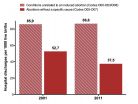Maybe it wasn't the Higgs particle after all
2014-11-07
(Press-News.org) Last year CERN announced the finding of a new elementary particle, the Higgs particle. But maybe it wasn't the Higgs particle, maybe it just looks like it. And maybe it is not alone.
Many calculations indicate that the particle discovered last year in the CERN particle accelerator was indeed the famous Higgs particle. Physicists agree that the CERN experiments did find a new particle that had never been seen before, but according to an international research team, there is no conclusive evidence that the particle was indeed the Higgs particle.
The research team has scrutinized the existing scientific data from CERN about the newfound particle and published their analysis in the journal Physical Review D. A member of this team is Mads Toudal Frandsen, associate professor at the Center for Cosmology and Particle Physics Phenomenology, Department of Physics, Chemistry and Pharmacy at the University of Southern Denmark.
"The CERN data is generally taken as evidence that the particle is the Higgs particle. It is true that the Higgs particle can explain the data but there can be other explanations, we would also get this data from other particles", Mads Toudal Frandsen explains.
The researchers' analysis does not debunk the possibility that CERN has discovered the Higgs particle. That is still possible - but it is equally possible that it is a different kind of particle.
"The current data is not precise enough to determine exactly what the particle is. It could be a number of other known particles", says Mads Toudal Frandsen.
But if it wasn't the Higgs particle, that was found in CERN's particle accelerator, then what was it?
"We believe that it may be a so-called techni-higgs particle. This particle is in some ways similar to the Higgs particle - hence half of the name", says Mads Toudal Frandsen.
Although the techni-higgs particle and Higgs particle can easily be confused in experiments, they are two very different particles belonging to two very different theories of how the universe was created.
The Higgs particle is the missing piece in the theory called the Standard Model. This theory describes three of the four forces of nature. But it does not explain what dark matter is - the substance that makes up most of the universe. A techni-higgs particle, if it exists, is a completely different thing:
"A techni-higgs particle is not an elementary particle. Instead, it consists of so-called techni-quarks, which we believe are elementary. Techni-quarks may bind together in various ways to form for instance techni-higgs particles, while other combinations may form dark matter. We therefore expect to find several different particles at the LHC, all built by techni-quarks", says Mads Toudal Frandsen.
If techni-quarks exist, there must be a force to bind them together so that they can form particles. None of the four known forces of nature (gravity, the electromagnetic force, the weak nuclear force and the strong nuclear force) are any good at binding techni-quarks together. There must therefore be a yet undiscovered force of nature. This force is called the the technicolor force.
What was found last year in CERN's accelerator could thus be either the Higgs particle of the Standard Model or a light techni-higgs particle, composed of two techni-quarks.
Mads Toudal Frandsen believes that more data from CERN will probably be able to determine if it was a Higgs or a techni-higgs particle. If CERN gets an even more powerful accelerator, it will in principle be able to observe techni-quarks directly.
INFORMATION:
The rest of the team behind the scientific paper is: Alexander Belyaev and Matthew S. Brown from the University of Southampton, UK and Roshan Foadi from the University of Helsinki, Finland.
About elementary particles
An elementary particle is a particle that cannot be divided into smaller components. For a long time it was believed that atoms were elementary, but in the early 1900s, it became clear that atoms consist of protons and electrons, and later also of neutrons. In the mid-1900s, it became further clear that protons and neutrons are composed of quarks, held together by the strong nuclear force. Since then, more have been added. Elementary particles are today divided into two categories: building blocks of matter (fermions) and carriers of force (bosons).
Ref: Technicolor Higgs boson in the light of LHC data. Phys. Rev. D 90, 035012th Alexander Belyaev, Matthew S. Brown, Roshan Foadi, and Mads T. Frandsen.
Contact: Mads Toudal Frandsen, associate professor. Tel: +45 6550 4521. Email: frandsen@cp3.dias.sdu.dk
[Attachments] See images for this press release:

ELSE PRESS RELEASES FROM THIS DATE:
2014-11-07
This news release is available in German. Microbiologists and molecular biologists at ETH Zurich and the University of Bonn have discovered a new agent in fungi that kills bacteria. The substance, known as copsin, has the same effect as traditional antibiotics, but belongs to a different class of biochemical substances. Copsin is a protein, whereas traditional antibiotics are often non-protein organic compounds.
The researchers led by Markus Aebi, Professor of Mycology, discovered the substance in the common inky cap mushroom Coprinopsis cinerea that grows on horse ...
2014-11-07
An international research project, which includes researchers from the U. of Granada, has proved the need for campaigns to persuade parents of the benefits involved in having their children walk to school. This also includes work on the perception about the security of the paths their children need to follo won the way to school. This research points out, besides, the need for public administrations to actively campaign to persuade children and their families to walk more often as part of their daily routines.
Many different surveys have demonstrated that walking to school ...
2014-11-07
Since suitable studies are lacking, it remains unclear in which sperm analysis parameters assisted reproduction using intracytoplasmic sperm injection (ICSI) can be superior to in vitro fertilization (IVF). This is the conclusion of the final report published by the Institute for Quality and Efficiency in Health Care (IQWiG) on 6 November 2014.
Benefit assessment depending on parameters
The Federal Joint Committee (G-BA) commissioned IQWiG with the examination of two research questions: First, the researchers were to assess the benefit of ICSI in comparison with IVF ...
2014-11-07
Eribulin (trade name: Halaven) is approved for women with locally advanced or metastatic breast cancer in whom the disease has progressed despite prior drug therapy. The German Institute for Quality and Efficiency in Health Care (IQWiG) examined in a dossier assessment whether the drug offers an added benefit over the appropriate comparator therapy in these patient groups.
According to the findings, there are both positive and negative effects. There is proof of minor added benefit for one group of patients. For other groups, there are hints or indications of lesser ...
2014-11-07
The current classification system for colorectal cancer, which is based on genetic expression profiles, cannot be used to predict drug responses to FOLFIRI. This is the conclusion reached by a team from the Spanish National Cancer Research Centre (CNIO), formed by members from the Gastrointestinal Cancer Clinical Research Unit and the Structural Computational Biology Group. The study, published this week in the journal Nature Medicine, will assist oncologists in making better-informed decisions regarding how to treat their colorectal cancer patients in the clinic.
Conclusions ...
2014-11-07
Published in Nature Biotechnology, the study showed that specially engineered lipid (fat) bodies, called liposomes, can be used to prevent bacterial toxins from killing human cells.
This could prevent unnecessary deaths from diseases such as pneumonia and sepsis. The treatment is a valuable alternative to current medications, particularly for infections that have become resistant to antibiotics.
The bacterial toxins, produced by major human pathogens such as Streptococcus pneumonia, Streptococcus pyogenes and Methicillin Resistant Staphlycoccus aureus (MRSA) were ...
2014-11-07
During hibernation, dormice enter into 'torpor' to save energy and water. In this state, the dormice become inactive and show a marked decrease in their metabolic rate, causing their body temperature to reduce.
Torpor was then found to be a strategy used when food availability was limited. The researchers compared two groups of juveniles born late in the season - one able to feed freely and the other intermittently fasted on alternate days. The fasted dormice showed considerably greater use of torpor, enabling them to maintain high growth rates and accumulate sufficient ...
2014-11-07
Muscle-specific protein cofilin-2 controls the length of actin filaments in muscle cells.
Sliding of myosin and actin filaments past each other provides the force for muscle contraction. In contrast to most non-muscle cells, the actin filaments in muscle sarcomeres are of precise length and relatively stable. Defects in the organization of these actin filament arrays result in various heart and muscle disorders, such as myopathies.
The research group of professor Pekka Lappalainen at Institute of Biotechnology, University of Helsinki, has now revealed a new mechanism ...
2014-11-07
Bethesda, MD -- After many generations, rats bred for their bad attitude behave differently from those selected for a calm demeanor around humans. Research published November 7 in the journal GENETICS identifies gene regions that contribute to differences between nasty and nice rats in their behavior and the activity of genes in the brain. These results may provide important clues as to which genes make tame animals like dogs behave so differently from their wild ancestors.
"Tameness is one trait that all domestic animals share. Whether it's pigs or cats or horses, domestication ...
2014-11-07
This news release is available in Spanish.
Legal restriction of abortion has a negative connotation since the idea of women resorting to illegal abortion -risking their own lives- is strongly rooted in the public opinion worldwide. However, a series of independently peer-reviewed articles, challenge this notion in some countries. The latest data in this subject have been discussed by the Chilean epidemiologist Elard Koch, Director of Research of the MELISA Institute, in the current issue of the official journal of the Chilean Society of Obstetrics and Gynecology. ...
LAST 30 PRESS RELEASES:
[Press-News.org] Maybe it wasn't the Higgs particle after all



